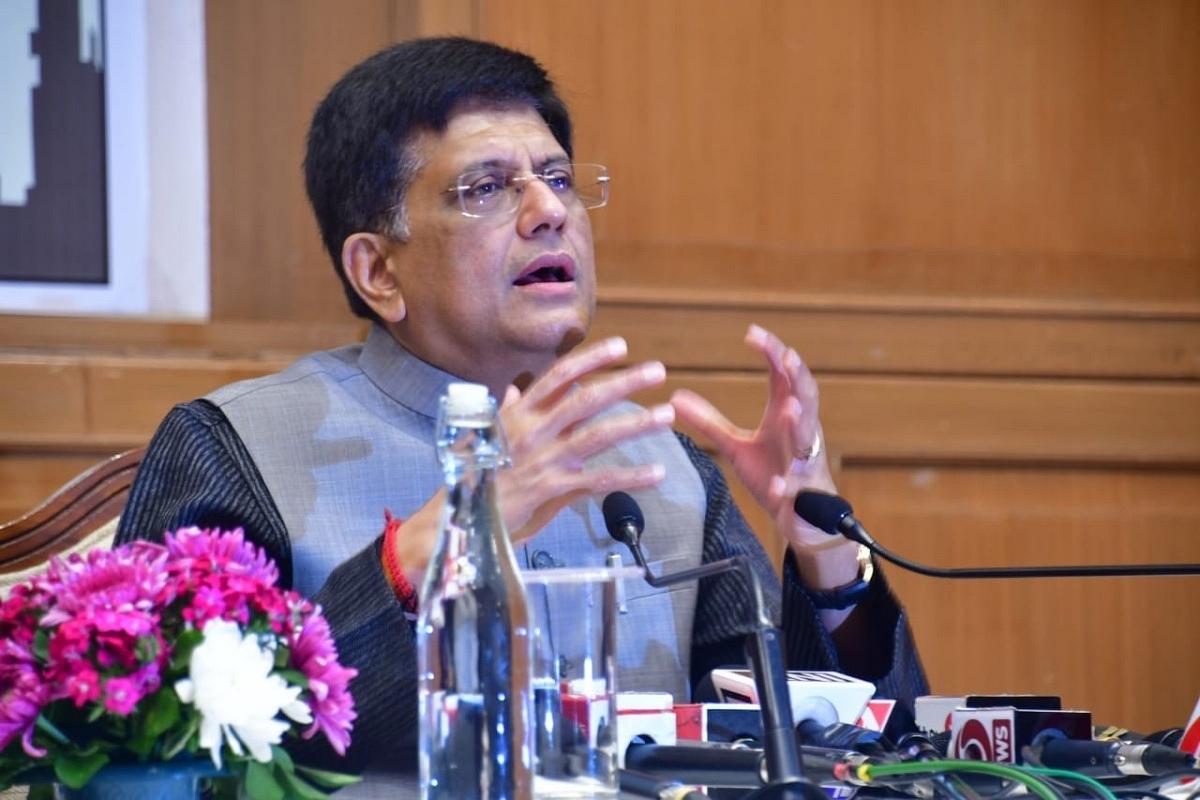Business
Indian Cotton Cultivators Should Adopt New Technologies To Gain From FTAs: Piyush Goyal
- India’s textile sector currently accounts for about 10 per cent and approximately $43 billion of India’s total merchandise exports, positioning the country as the largest producer of cotton with 23 per cent of global production, sustaining 65 lakh people directly and indirectly.

Piyush Goyal (Pic Via PIB Website)
With India creating a favourable pitch for boosting exports of textiles in recent free trade agreements and optimistic of the UK, EU, Canada and GCC countries allowing zero-duty imports of Indian textiles in trade deals under negotiation, Minister of Commerce and Industry Piyush Goyal wants Indian cotton cultivators to adopt new technologies and global best farm practices as well as build capacity towards achieving the potential $100 billion in exports by 2030.
The new Economic Cooperation and Trade Agreements with Australia and UAE can open infinite opportunities for textiles exports to these two destinations as they would now face zero duty and it was only right that India opens up to receiving new technology and raw materials -- which are in short supply in India -- from the world at reasonable costs.
Increase in India’s production, productivity and quality is imperative to India’s ambition of atmanirbharta in quality, reliability and innovation in textiles and using it for increasing demand for its products all over the world, Goyal said, addressing the Confederation of Indian Textile Industry- Cotton Development and Research Association (CITI- CDRA) on Tuesday (12 April) which also hosted Vice President M Venkaiah Naidu as chief guest to mark the Golden Jubilee Celebrations of the CITI- CDRA.
India’s textile sector currently accounts for about 10 per cent and approximately $43 billion of India’s total merchandise exports, positioning the country as the largest producer of cotton with 23 per cent of global production, sustaining 65 lakh people directly and indirectly.
India’s export of textiles and apparel during April-January 2021-22 stood at $34.46 billion posting a growth of 49 per cent over the same period in 2020-21. According to government estimates, India should be in a position to take textile exports from the current $40 billion to $100 billion in the next five years.
The drive to expand the footprint of the textile sector comes at a time when the world is looking for alternative manufacturing sourcing hubs owing to geopolitical reasons. The government is also keen to encourage innovation, research and development to allow the sector to leverage the opportunities being opened up through trade deal.
For instance, the AI technology is enabling farmers in Australia to control spraying operations, as cotton crop is sensitive to spraying through data-driven decision making. Modern Australian cotton growers also serve as drone pilots, data analysts and agri-scientists. Augmenting the capacity of Indian farmers and skilling them in allied areas would help tap such opportunities in the textile trade.
According to Ravi Sam, Chairman of the Southern India Mills’ Association (SIMA), the estimated bilateral trade of $50 billion in five years would enable the textile industry to gain major advantage. “Especially for the import of high quality cotton produced by Australia and export of high value added textiles and clothing products to Australia with 7-10 times value addition and thereby create new jobs and fetch more revenue to the government,” says the SIMA Chairman
The recently signed India UAE CEPA offers India’s textiles sector an additional increase in exports projected at $2 billion over the next five years and for man-made fibre textiles duty free exports over next five years projected at $650 million/year.
Till November 2021, exports of cotton textiles from India to UAE were $223 million, a growth of 28 per cent over the same period in 2019. With duty free tariffs, India can cater to the hospital segment of UAE through institutional selling of home textiles like bed and bath linen as well as contract textiles like beach towels, salon and spa linen etc. India will be able to more than double its exports in the coming years to a level of $500 million.
Apparel Export Promotion Council Chairman Narendra Goenka would like the apparel sector to prioritise to leverage the upcoming FTAs as well as policy support for improving scales, product diversification, use technology and AI for leaner supply chain and better branding for holistic development of the apparel sector.
Even as India’s designs on the global textile supply chain is being nurtured by industry efforts led by CITI-CDRA to develop a robust cotton ecosystem by directly engaging about 90,000 cotton farmers, the government is also pushing to attract investment, boost employment generation and increase production through the Production Linked Incentive (PLI) Scheme for Textiles and Pradhan Mantri Mega Integrated Textile Region and Apparel Parks (PM-MITRA) scheme for setting up seven mega textiles parks over a period of three years.
India is getting ready to compete globally with the PLI scheme for textiles which will promote production of high value Man-Made Fibre (MMF), garments and technical textiles in the country while the PM-MITRA scheme will allow development integrated large scale and modern industrial infrastructure facility for the entire value-chain of the textile industry. It will also enhance competitiveness of the textiles industry by helping it to achieve economies of scale.
Introducing ElectionsHQ + 50 Ground Reports Project
The 2024 elections might seem easy to guess, but there are some important questions that shouldn't be missed.
Do freebies still sway voters? Do people prioritise infrastructure when voting? How will Punjab vote?
The answers to these questions provide great insights into where we, as a country, are headed in the years to come.
Swarajya is starting a project with an aim to do 50 solid ground stories and a smart commentary service on WhatsApp, a one-of-a-kind. We'd love your support during this election season.
Click below to contribute.
Latest